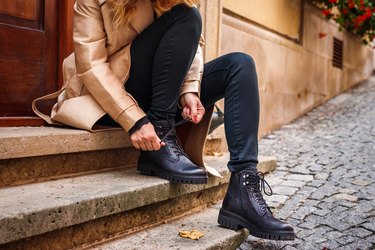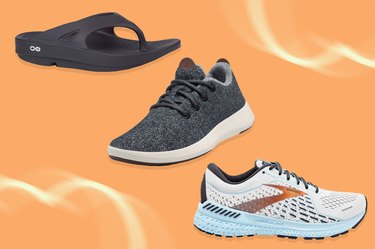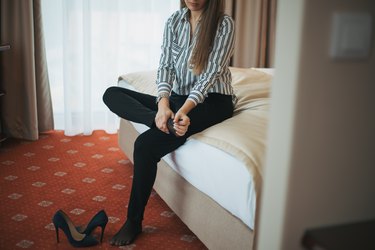
Bunions are a bummer. Not just unsightly, these bony bumps beside your big toe can limit joint mobility, produce pain and trigger tingling and numbness (due to bone pressing against nerve), says Nelya Lobkova, DPM, a New York City-based podiatrist at Step Up Footcare.
But many bunions — unless they're at a severe stage — can often be managed with non-invasive, home-based treatments.
Video of the Day
Video of the Day
Here, Dr. Lobkova shares which home remedies for bunions actually work and when it might be time to talk to a foot doctor for a stronger solution.
First Things First, Can Bunions Be Reversed?
Bunions can only be permanently remedied through surgery (more on this later).
Here’s why: Bunions are a progressive condition. That means they get worse over time. “It’s just a matter of time before a mild bunion will become a moderate to severe bunion,” Dr. Lobkova says.
But it’s not all bad news: “Bunions progress over many years, and the rate of progression varies among people, depending on activity level, shoe wear and genetic factors,” Dr. Lobvoka says. And many home remedies can slow down the progression of bunions and improve symptoms including pain, numbness and decreased range of motion of the big toe joint, Dr. Lobkova says.
While the following fixes can't banish bunions for good, they can certainly help keep your bunions at bay.
1. Bunion Correctors
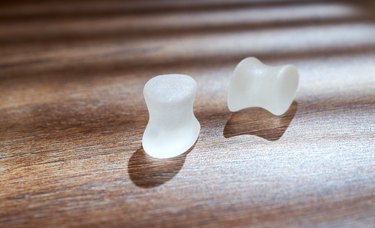
Bunion correctors are exactly what they sound like: little devices — from braces to splints — that can help correct (at least temporarily) the misalignment of the big toe.
But not all bunion correctors are made equally.
"Bunion correctors can be bulky, which makes them difficult to fit into shoes or even slippers," Dr. Lobkova says. What's more, some products are manufactured with rough materials (think: plastic), which can rub and irritate the skin, she says.
Adding to the irritation, certain correctors cover the medial "bump," but the skin that overlies the bump is very sensitive and can break from the friction, Dr. Lobkova says.
All this is to say, when buying a bunion corrector, look for soft materials like gel or neoprene and opt for applicators that don't overlay the bump.
Dr. Lobkova recommends NatraCure Gel Toe Separators ($14.99 on Amazon), a toe spacer that easily fits inside footwear and separates your big toe from your second toe. As a bonus, this bunion corrector is made with smart gel technology that slowly releases mineral oil, vitamin E and aloe vera to reduce friction (and keep your delicate skin moisturized).
2. Stretching
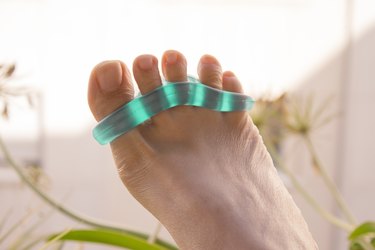
Stretching can be a salve for your bunion problems.
"It is important to stretch the calf and arch of the foot to reduce pressure on the bunion," Dr. Lobkova says.
Decreasing calf and arch tightness can not only lessen bunion pain but also slow your bump's progression, she says.
Double heel lifts are Lobkova's go-to stretch to tamp down tension in the calves and feet. Here's how to do them: Simply stand with feet hip width apart, loop a mini band around both big toes and raise your heels off the ground. Do three sets of 12 lifts each day for the best results.
You can also stretch the ligaments in the toes directly by using toe separators, Lobkova says. She recommends ViveSole Toe Stretchers ($11.99 on Amazon), which are made with a soft silicone gel and provide comfortable cushioning between each toe to gently stretch and realign them.
3. Wearing the Right Shoes
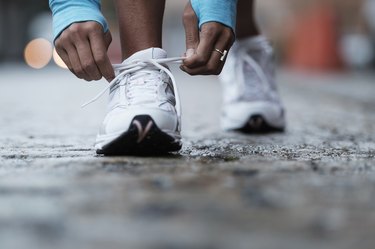
What you wear on your dogs can make a huge difference in the bunion department.
"Choosing the right footwear can prevent pain and disability with a bunion deformity," Dr. Lobkova says, noting that the best shoes for bunions allow for normal toe flexion without crowding the toes.
Shoes with arch support, especially along the inside of the foot, can also help slow down the progression of bunions, Dr. Lobkova says. That's because appropriate "arch support contributes to metatarsal stability and minimizes pathological wear and tear of the big toe joint," she explains.
In addition to a wider forefoot, look for shoes with the following characteristics:
- Soft upper material: A gentle material will reduce rubbing on the bunion joint, "and thus diminish pain and irritation of the soft tissue surrounding the joint," Dr. Lobkova says. "For instance, a soft and flexible upper material like goat leather or neoprene will conform to the contour of the foot instead of pressing up against the joint."
- At least a 1-inch heel: "Totally flat footwear, including flat sneakers, is worse for bunions than a 1 to1.5-inch heel or platform," Dr. Lobkova says. What's more, "lifting the heel slightly causes the rest of the foot to rotate in a more optimal biomechanical position that puts less pressure on the big toe joint," she explains.
- Open-toed (when possible): "In general, open-toe shoes are better than closed-toe shoes for people with bunions," Dr. Lobvova says. "However, it is important to note the placement and material of the sandal straps," which can potentially irritate the joint, she adds. "Avoid sandals with more than three straps or thin straps made from rough material like PVC."
4. Icing
When you have a sore muscle or injury, you might turn to ice therapy to minimize aches and pains. And the same holds true for a bunion that's bothering you.
"Icing reduces inflammation," Dr. Lobova says. That's why it can help provide temporary pain relief if your bunion site becomes aggravated or inflamed (think: a red, warm and swollen big toe joint) due to activity or ill-fitted shoes, she says.
So, how long should you apply ice to your bump? Dr. Lobkova recommends icing for 10 minutes on and 20 minutes off over the course of an hour.
5. Taping
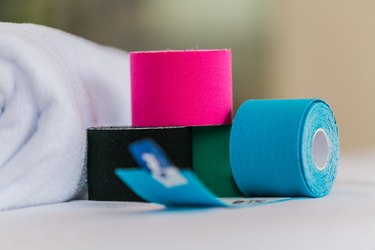
Believe it or not, strategic use of tape can temper your bunion. As a bunion corrector, the safest type of tape is kinesiology (also called kinesio) tape, a stretchy, moveable tape that's used to support and alleviate pain in muscles, joints and/or ligaments, Dr. Lobkova says.
Try Kinesio Tex Gold Kinesiology Tape ($12.99 on Amazon).
"Since the bunion is a joint deformity, applying kinesio tape works to realign the misaligned joint and compress the painful tissue overlying the bunion bump," she says.
Here's how to do it:
- Start with a roll of 1-inch wide kinesio tape and measure from the side of the big toe to just above the heel.
- Measure a second strip around the foot using 2-inch wide kinesio tape, just below the toes, leaving approximately a half inch between the ends.
- With a scissor, carefully cut all the edges of both tape strips to create a rounded shape. This will help avoid the tape catching on your clothes.
- Anchor the first 1-inch strip to the side of the big toe and apply down the side of the foot, rubbing to activate the adhesive.
- Loop the second 2-inch strip just below your toes, making a slight stretch in the part of the tape that covers the bunion. Lay down the ends with no stretch and rub to activate the adhesive.
Because kinesio tape won't restrict your range of motion, you can wear it while working out and with all kinds of shoes, including heels, Dr. Lobkova says.
"Another plus: You can shower and sleep with kinesio tape on your foot without worrying about cutting off circulation or macerating the skin [i.e., over-moistening that can cause damage to the skin]," she adds.
6. Over-the-Counter Pain Relievers

"OTC pain relievers can temporarily provide pain relief associated with bunions," Dr. Lobkova says. Typically, topical voltaren gel (a nonsteroidal anti-inflammatory) and oral naproxen (i.e. Aleve) work best, she says.
Nonetheless, these are only short-term solutions. "They do not address or support the deformity," Dr. Lobkova says. "In addition, it is not advised to use these products for over two weeks because of associated side effects," she adds.
Related Reading
When to See a Doctor for Bunions
If your bunion is bothering you, you might need a stronger intervention.
"When there is a deformity in the big toe joint that is causing any pain or discomfort, I advise seeing a podiatrist to get an X-ray and understand the etiology of the problem," Dr. Lobkova says.
Depending on the issue, your doctor may decide to treat you with hyaluronic acid injections or construct custom orthotics, she says.
Custom orthotics place your foot in a neutral position by providing the correct tilt in the heel as well as arch support, and they can include specific modifications for bunions (like a deeper cutout under the big toe joint) to allow for more room in the shoe and an increased range of motion, Dr. Lobkova says.
In severe cases, surgery might be an option. "Surgical bunion repair typically involves resection of the bump and/or realignment of the great toe joint," Dr. Lobkova says. This may include open surgery with hardware and immobilization or a minimal incision procedure.
"Based on X-ray imaging and clinical examination, your podiatrist will discuss which type of surgery and surgical technique is right" for you, Dr. Lobkova says.
But to be clear: Surgical repair should be a last resort. "Bunion surgery should only be considered once conservative care is exhausted, including custom orthotics, kinesio taping and other treatments that help manage the onset of these complications," Dr. Lobkova says.
Is this an emergency? If you are experiencing serious medical symptoms, please see the National Library of Medicine’s list of signs you need emergency medical attention or call 911.
